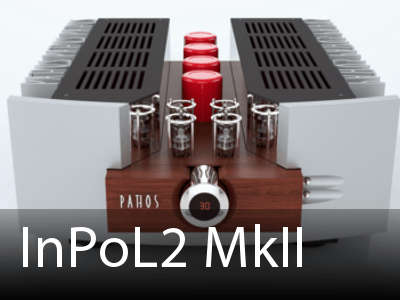
The beauty of ambiguity - Pathos Inpol 2 mkII
In the next issue of "Audio" - a test of an unusual amplifier - Pathos Inpol 2 mkII. Even among expensive, luxurious and avant-garde products, this product is unique, controversial and even perverted. We will consider it without a ready thesis, consider the correctness of the assumptions of the construction and the ambiguity of some premises. But no matter what conclusions we come to, we will definitely get acquainted with a very interesting and beautiful structure. By the way, let's recall the elementary parameters of amplifiers.
It uses many solutions that are well associated with audiophiles - they have an opinion on the way good soundalthough they do not always or even rarely give good results for basic measurements. Already in this proposal there are several shortcuts and pitfalls.
What does "basic measurements" mean? Traditionally, in instrumentation amplifiers, they rated power measurement (set to 1% THD + N) for various load impedances (allowed by the manufacturer), transmission frequency response (at 2,83 V), distance from noise (2,83 volts into 8 ohms). To these can be added the measurement of the output impedance (which determines the damping factor), the THD + N characteristic depending on the power (for a specific frequency, 1 kHz is standard), the harmonic spectrum (1 kHz, at a specific power - for example, 1/4 of the rated power).
This set of measurements is provided by the AUDIO laboratory. Much and little. It is difficult to examine each amplifier tested even more precisely, although it is easy to imagine that even the above measurements could be extended multidimensionally, for example, by examining the harmonic spectrum for a different fundamental frequency and a different power or output power with a different impedance response (actually not a resistive load). This set does not include many other types of non-linear distortions - phase, differential, intermodulation, which can be divided into even more "specialized" varieties. Among these, often mentioned are TIM (transient intermodulation) distortions that occur in transient states, which are the essence of musical signals.
The circuit solutions included in the Inpol 2 mkII and listed below may be necessary to improve some, even very important and objective sound parameters and aspects. But concepts alone do not guarantee success. Most of them require special care in execution. Even if we acknowledge the importance of TIM distortion, other measured parameters still matter. You don't have to sacrifice all other parameters to reduce one type of distortion. How much can you donate? Each designer is looking for an answer and his own recipe for this question. Audiophiles are also looking for it, although not based on measurement analysis. But they pay attention to more than just sound… If that were the case, you could leave them with the final say and be guided by the clues that flow from their relationship.
audio file They also licked off some technical knowledge, and since the listening experience is much more subjective, an amplifier that is known to contain a range of ambitious, extravagant or purist solutions often sounds "better" than "normal", even the most honestly prepared one. On the one hand, we have an incomplete picture based on measurements, which, however, “do not lie” and warn of real problems, on the other hand, an overall picture based on a listening session, which, however, can be distorted.
Briefly - Inpol 2 mkII - hybrid amplifier. Typically the term is a combination of a tube preamplifier with solid state power amplifiers. Based on a cursory examination, it may seem that this scheme is duplicated by Inpol 2 mkII. A quartet of tubes is visible in the foreground, and radiators with transistors hidden inside are visible on the sides. However, this is not a "regular" hybrid. For years, Pathos has been using a patented solution called InPol (and that's what they call amplifiers based on it). The idea in general assumptions is even older, but so unique that it is now associated with Paphos.
In a typical hybrid amplifier, the tube preamplifier provides little pre-amplification (and, whether it does or not, a lot of tone shaping), and the transistorized power amplifier provides additional voltage amplification, while still allowing a low-impedance load (loudspeakers) to be connected, which related to the current capability of the system.
In the InPol circuit, only part of the tube provides voltage amplification. However, this is not the end of the matter, since such a system is not capable of providing low impedance (it cannot deliver high current). For this reason, output transformers are a common solution in tube amplifiers, the task of which is to match the requirements of tubes to a “loud-speaking” load (excluding exotic transformerless overhead lines).
In the InPol circuit, instead of output transformers, there is a transistor section, but it does not work like a typical power amplifier. Consequently, the power of InPol circuits is not as high as that of typical hybrids, which are comparable in power to transistor amplifiers. InPol reduces the influence of transistors on the sound, leaving them the same as the tubes in the preamp section. The power amplifier here can be considered as a matching buffer that provides comfortable operating conditions for the tube circuit responsible for amplification. The power amplifier has a voltage gain equal to unity (according to the manufacturer, and according to some sources, a little more, around 1,3, but this does not change the essence of the matter).
Both sections operate in class A; even at idle, the amplifier heats up instantly, and even at low power it gets very hot. To increase the efficiency of the tip, another original solution appears - an additional passive circuit, called by Paphos an energy storage device. It consists of a large coil and a block of coupling capacitors. We do not know the exact values of the elements used in the Inpol 2 mkII, but in previous similar projects Pathos used coils with inductances over 100 mH. This high inductance requires a thick wire and core to maintain moderate resistance, so these coils look like transformers (but only have one winding).
The system operates without global feedback. This is always a risky decision as there is a risk of increased noise, harmonic distortion and output impedance, but the coupling itself also introduces distortion that purists consider the worst. The lesser evil (for sound) should be high THD+N and low damping factor.
The whole system is balanced. The volume control system is exceptionally advanced and rare; As a rule, manufacturers (even in very expensive devices) use ready-made regulators in the form of integrated circuits, and Paphos designed his own circuit from a battery of relays and resistors.
Finally, the entire amplifier is a dual mono circuit with double the power section - there are two large toroidal transformers.
Laboratory
Expect 2×45W into 8 ohms and 2×75W into 4 ohms, according to the manufacturer. At 8 ohms we measured 2 x 55 watts (a dual mono system guarantees the same level of power when running one and two channels at the same time), but at 4 ohms the power dropped to 2 x 36 watts.
The distance to the noise is low (78 dB), which could be expected from a large pipe section. On the other hand, the transmission characteristics are quite satisfactory as they reach (without any reduction in the low frequency range) up to about 70 Hz (3 dB reduction at both 4 and 8 ohms).
The output impedance is high - 0,37 ohms/1kHz, which means a damping factor of 11 with respect to a 4 ohm load - which is typical for tube, not hybrid (transistor) amplifiers.
On the other hand, transistor distortion is associated with odd harmonics, but here the third is the strongest (high -62 dB); fortunately the second one is a few decibels lower (-66 dB) and the other one is lower than -90 dB. The situation looks very good for a circuit without feedback.
The better behavior of the amplifier with an 8 ohm load, noted by the higher output power, is also confirmed by measuring THD + N as a function of power - this resistance ensures their lower level over the entire tested range. Distortion builds up slowly, without the sudden distortion typical of transistor amplifiers - so the Inpol 2 mkII behaves like a tube amplifier in this respect.
